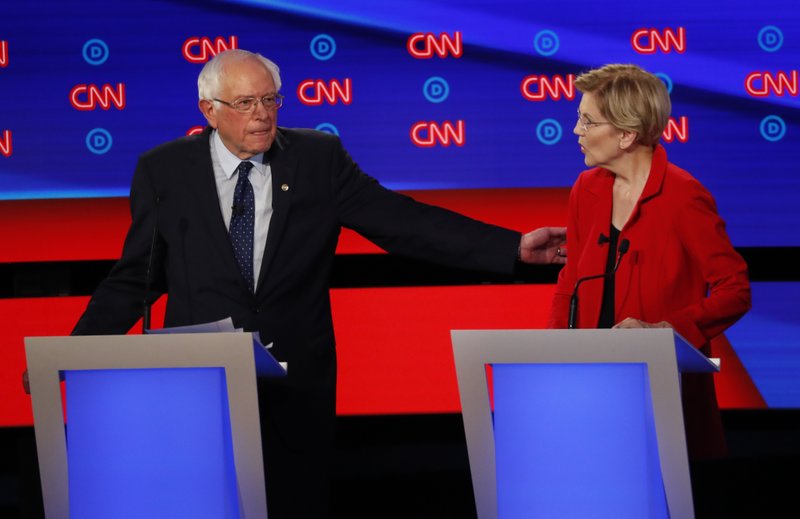PROGRESSIVE PERSPECTIVE: Sanders, Warren campaigns far from identical
Photo courtesy of the Associated Press
Sen. Bernie Sanders, I-Vt., gestures toward Sen. Elizabeth Warren, D-Mass., during the first of two Democratic presidential primary debates hosted by CNN Tuesday, July 30, 2019, in the Fox Theatre in Detroit.
As in recent weeks Joe Biden has repeatedly face-planted on the campaign trail and nosedived in polls across the nation, Sens. Bernie Sanders and Elizabeth Warren have established themselves as clear frontrunners to overtake the top spot among potential Democratic voters.
As such, a common narrative has developed throughout mainstream media and political discourse in the U.S., painting the campaigns of the two senators as equally populist and progressive and, at least for voting purposes, practically identical.
Last week, MSNBC invited Emily Tisch Sussman, a Democratic strategist and former vice president of campaigns for the Center for American Progress, onto their program. She went as far as to claim, “Basically, at this point, if you are still supporting Sanders as opposed to Warren, it’s kind of showing your sexism,” mirroring arguments made throughout corporate media by Hillary Clinton supporters in 2016 and implying the two campaigns are so similar that their defining difference is in the genders of the two candidates.
The problem with such a narrative is that it is demonstrably false.
Of the many differences between the two candidates and campaigns which will be closely examined by potential voters in all-important months ahead, several stand out as particularly defining and notable.
One difference between the two campaigns often cited by progressive Democrats and populist Independent potential voters alike is related to perhaps the most crucial issue facing Americans today: healthcare.
While Sanders has introduced a bold plan to eliminate all medical debt in the country, currently totaling $81 billion, Warren has remained relatively silent, only occasionally throwing tepid support behind a vague version of Medicare for All, then in other moments electing to retract that support.
This is likely a crucial decision-making factor for some 500,000 Americans who go bankrupt each year from medical bills and some 40,000-50,000 who die each year unable to afford healthcare.
A second difference deals with a different sort of debt, which has become the defining characteristic in the lives of a generation of Americans struggling to find their footing in an economy they have discovered to be rigged to work against them.
While Sanders has released a thorough plan to eliminate all student loan debt in the country, currently worth about $1.6 trillion, Warren’s plan forgives only a fraction of that debt, calculated based on the wealth of the individual attempting to pay off their loans.
Indeed, Warren’s plans across various fundamental issues affecting the American working-class display a pattern of mirroring Sanders’ plans, with slightly less radical—and less populist—outcomes and ideals.
Another difference deals not with policy plans of debatable outcomes in the future, but with concrete voting records of which Americans—and countless citizens abroad—have already experienced various disastrous pitfalls as a result.
As Warren voted, more than once, to increase the Trump Administration’s already bloated—$700 billion—defense budget, Sanders has principally opposed on each of several occasions.
The number of lives lost at home and abroad at least partially due to the bipartisan approval of this massive American war-making budget are genuinely incalculable. While Warren, having accepted large amounts of money from the Military Industrial Complex—notably from defense contracting corporation Raytheon, which is headquartered in Warren’s home state of Massachusetts—has proven herself complicit in endless American wars, Sanders, funded mostly by teachers, Walmart and Amazon employees, has dedicated decades of his life to ending them.
Much the same way, Warren has spent most of her political career—and her lifetime—attempting to appease and remain a part of the same political system and status quo that Sanders has spent his lifetime fighting to fundamentally transform.
As detailed in a May 2019 Politico cover story by Alex Thompson, “Warren used to be on the other side of the fight she is now waging. For many years before she entered politics, the woman now at the forefront of the progressive wing of the Democratic Party was a Republican.”
Later in the article, one of Warren’s best friends from high school, Katrina Harry, explains, “Liz was a diehard conservative in those days.”
During “those days,” as is evident in various black-and-white photos that have repeatedly gone viral on social media, Sanders, an avid admirer of Dr. Martin Luther King Jr., could be found organizing and participating in protests for civil rights in Chicago, going so far as to chain himself to black fellow protestors, refusing to move even when arrested by Chicago police.
Warren remained a member of the Republican Party until after the beginning of her political career, electing to switch to the Democratic Party in 1996 when she was almost 50 years old. By that time, Sanders had been organizing, campaigning and legislating against politics-as-usual for nearly three decades.
Even since switching sides, Warren has repeatedly displayed her affinity for corporate democracy and those ensuring and benefiting greatly from its continued existence.
In an interview with The Young Turks earlier this year, Warren explained that while she is not accepting corporate, Big Money campaign contributions in the Democratic Primary, she will not hesitate to do so in the general.
Despite promising to not accept Big Money donations in the primary, Warren has transferred more than $10 million toward her 2020 presidential campaign from her 2018 campaign for senate, during which she accepted millions from Big Money donors, PACs and lobbyists.
As reported by the New York Times last month, “The open secret of Ms. Warren’s campaign is that her big-money fund-raising through 2018 helped lay the foundation for her anti-big-money run for the presidency.”
Meanwhile, Sanders has garnered in the past year over three million contributions from more than one million individual donors, raising about $61.5 million at an average of just $19 per contribution. Sanders’ collecting over $25 million in the most recent fundraising quarter constitutes the most money raised by a Democratic presidential candidate in any of the 2019 fundraising quarters and more than Warren collected through the first two fundraising quarters combined.
Sanders has for decades understood the corrupting influence of Big Money in politics and dedicated his work to combatting and ending it. Such will not change in the general election. While Warren may claim to understand the corruption inherent in accepting Big Money contributions, she remains adamant about participating in said corruption in the general election.
Even leaving out several other major differences between the candidates and their campaigns—including Warren’s “spirited defense” of Joe Manchin while his 2016 primary challenger, Paula Jean Swearengin, acts as a surrogate for Sanders’ 2020 campaign, and her lack of a comprehensive K-12 education plan in the face of Sanders’ plan to ensure all public-school teachers are paid at least $60,000 a year amongst other improvements—the contrasts are stark.
This is not to say every potential Democratic or Independent voter ought to support Sanders over Warren, but rather, those pronouncing throughout corporate media and mainstream political discourse the absurdity of supporting Sanders over Warren despite their seeming likeness are either misinformed, lying or performing propaganda. Sanders and Warren are not one and the same, and their many major differences are far from nonexistent, meaningless or unsubstantial.
Douglas Harding can be contacted at harding26@marshall.edu.
Your donation will help continue the work of independent student journalism at Marshall University. If you benefit from The Parthenon's free content, please consider making a donation.












